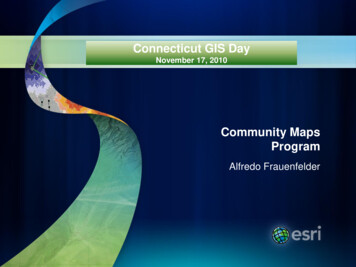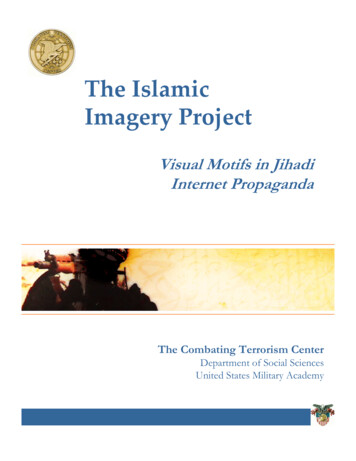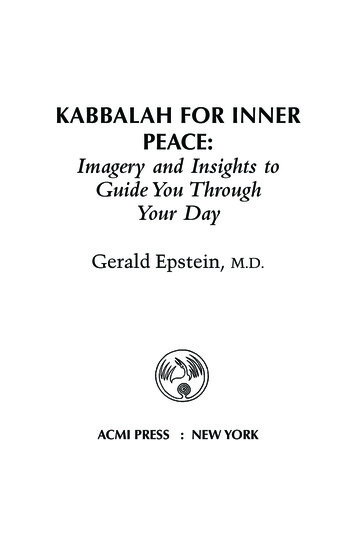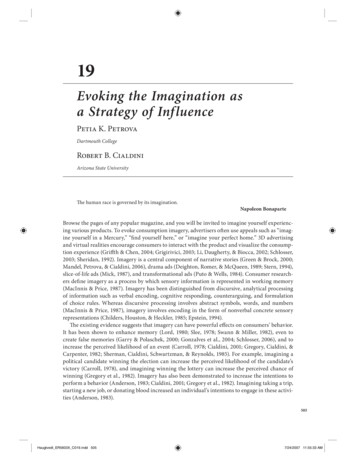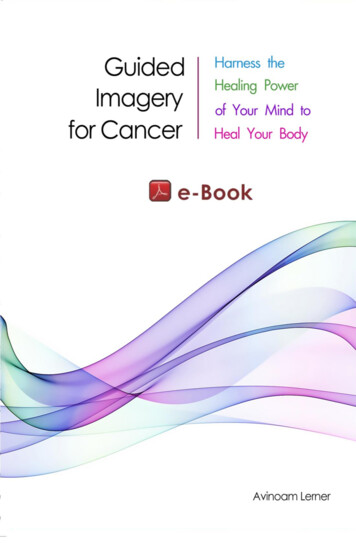
Transcription
International Journal of Cognitive Therapy (2021) 02-0Mental Imagery in the Science and Practiceof Cognitive Behaviour Therapy: Past, Present,and Future PerspectivesSimon E. Blackwell 1Accepted: 15 January 2021 / Published online: 1 February 2021# The Author(s) 2021AbstractMental imagery has a long history in the science and practice of cognitive behaviourtherapy (CBT), stemming from both behavioural and cognitive traditions. The pastdecade or so has seen a marked increase in both scientific and clinical interest in mentalimagery, from basic questions about the processes underpinning mental imagery and itsroles in everyday healthy functioning, to clinical questions about how dysfunctions inmental imagery can cause distress and impairment, and how mental imagery can beused within CBT to effect therapeutic change. This article reflects on the current state ofmental imagery in the science and practice of CBT, in the context of past developmentsand with a view to future challenges and opportunities. An ongoing interplay betweenthe various strands of imagery research and the many clinical innovations in this area isrecommended in order to realise the full therapeutic potential of mental imagery inCBT.Keywords Mental imagery . Cognitive behaviour therapy . Imagery rescripting . Imaginalexposure . Treatment mechanismsMental imagery has played a role in cognitive behaviour therapy (CBT) throughout itshistory, but the past decade or so has seen an acceleration of interest in the use ofmental imagery across an ever-growing range of disorders and treatment applications(Saulsman et al. 2019). Several converging factors have likely contributed to this risinginterest in and use of imagery. First, there has been a broader scientific resurgence ofinterest in mental imagery, facilitated both by the advent of better neuroimagingtechniques, allowing insights into the neural underpinnings of imagery (Kosslynet al. 2001; Pearson et al. 2015), and by experimental work supporting the perceptual* Simon E. Blackwellsimon.blackwell@rub.de1Mental Health Research and Treatment Center, Faculty of Psychology, Ruhr-Universität Bochum,Massenbergstrasse 9-13, 44787 Bochum, Germany
International Journal of Cognitive Therapy (2021) 14:160–181161nature of much emotional memory (e.g. Andrade et al. 1997; Arntz et al. 2005; Brewinand Saunders 2001), and testing the assumption of a special relationship betweenimagery and emotion (e.g. Holmes and Mathews 2005). Second, there has beengrowing recognition and documentation of the presence of mental imagery dysfunctions across the whole range of psychopathology (e.g. Holmes and Hackmann 2004).Third, there has been increasing clinical interest in the potential applicability ofmethods developed within the context of trauma memories, such as imageryrescripting, to other kinds of distressing memories and problematic imagery morebroadly (e.g. Arntz and Weertman 1999; Holmes et al. 2007a). This convergence ofscientific and clinical interest has led to a particularly fertile interplay between basicresearch and applied clinical work.This article reflects on the current status of mental imagery in the science and clinicalpractice of CBT, in the context of past developments, and with a view to futurechallenges and opportunities. After a brief introduction to mental imagery, this articlewill consider past and present developments of relevance to CBT, organised into thefollowing four broad categories of work spanning science and practice: the use ofmental imagery as an experimental tool to test and develop underlying theories;understanding the role of mental imagery in healthy everyday functioning; understanding of the role of mental imagery dysfunctions in psychopathology; and the use ofmental imagery as a therapeutic tool within CBT itself. Finally, building on thisoverview of the present state of the field, the article will consider future perspectivesfor imagery in CBT research and treatment development. The article is not intended asa comprehensive review (and does not consider broader applications of imagery withinthe CBT context, for example to therapist self-care, training, or supervision e.g.Bennett-Levy et al. 2009; Prasko et al. 2020), but rather highlights selected examplesof past and current work to illustrate broader patterns and trends in the field. The‘present status’ of CBT-relevant mental imagery research is very much informed by theprogramme of the 2019 World Congress of Behavioural and Cognitive Therapies(WCBCT; Heidenreich et al. 2019; Heidenreich and Tata 2019), at which the numerouspresentations on the topic of mental imagery spanned disorder areas including depression, anxiety disorders, addictions, and psychosis, illustrating the breadth of clinicalinterest at the present time. By providing an overview of where mental imagery standsat the current crossroads of science and clinical practice, the article aims to stimulatereflection and promote continued interchange across the many strands of work relevantto understanding how we can make best use of mental imagery in CBT.Why Focus on Mental Imagery?Mental imagery can be defined as “representations and the accompanying experienceof sensory information without a direct external stimulus” (Pearson et al. 2015, p. 590),or in more colloquial terms as “‘seeing with the mind’s eye,’ ‘hearing with the mind’sear,’ and so on” (Kosslyn et al. 2001, p. 635). Most of us will be familiar with theexperience of mental imagery in our daily lives, for example when we recall an eventfrom memory and replay the scene in our mind, or when we think forward to anupcoming event and ‘pre-experience’ some anticipatory emotion, such as excitement ordread, as we play out in our mind’s eye the different ways in which the event could
162International Journal of Cognitive Therapy (2021) 14:160–181potentially unfold. Many of us will also be familiar with the problematic imageryreported by patients or clients in clinical practice, for example distressing memories thatreturn uncontrollably again and again, or upsetting scenes of anticipated catastrophes ordisappointments. However, despite the ubiquity of mental imagery, clinicians, researchers, and patients may not always be aware of the scientific basis for consideringit as a form of thought deserving particular attention in CBT (e.g. Bell et al. 2015;Blackwell 2019).From a basic research perspective, experimental investigations have shown thatimagery-based thought can have particularly strong effects on emotion, cognition,and behaviour compared to non-imagery (e.g. verbal) thought (see e.g. Blackwell2019; Holmes and Mathews 2010, for overviews). This is most likely due to the natureof the representation of imagery at a neural level, which is very similar to that for actualperception of sensory input (Pearson et al. 2015), and leads to imagery having an ‘as-ifreality’ quality (Ji et al. 2016). From a more clinical perspective, the presence ofdysfunctional imagery has been documented across an increasing range of disorders(Ji et al. 2019), and thus neglecting imagery in theoretical conceptualisations or clinicalassessments risks excluding a potential key contributor to distress, functional impairment, and symptom maintenance. This point is particularly important given thatpatients may not report imagery unless it is explicitly asked about (e.g. Beck et al.1979; Hales et al. 2014). Finally, an awareness of mental imagery, its functions, andproperties, open up opportunities for a range of powerful therapeutic applications, fromincorporation of imagery into ‘standard’ therapy tools such as thought records(Josefowitz 2017), to use of imagery-based techniques such as imagery rescripting(e.g. Arntz 2012; Strachan et al. 2020), and even complete CBT treatment programmesthat have a specific focus on imagery (e.g. Holmes et al. 2019; Jung and Steil 2013;McEvoy and Saulsman 2014; Taylor et al. 2019). Arguably, discussion of almost anypsychological process, psychopathological phenomenon, or treatment technique isincomplete unless the potential role of mental imagery has been explicitly considered(Blackwell 2020).Mental Imagery Across the Science and Practice of CBTThe next sections will consider four ways in which mental imagery is of relevance forthe science and practice of CBT: use of mental imagery as an experimental tool;understanding the role of mental imagery in healthy everyday functioning; mentalimagery dysfunctions in psychopathology; and the clinical application of mentalimagery-based techniques within the practice of CBT.Mental Imagery as an Experimental ToolThe practice and continued development of CBT is rooted in theories and models of therole of cognition, behaviour, emotion, and physiology in the maintenance of psychopathology, and these theories and models can be tested and informed by scientificinvestigation. From a basic science perspective, the properties of mental imagery, suchas its effect on emotion, cognition, and behaviour (Blackwell 2019), and more broadly,ability to serve as a simulation of reality (Ji et al. 2016), mean that imagery can provide
International Journal of Cognitive Therapy (2021) 14:160–181163a valuable experimental tool to probe numerous aspects of the theories underpinningCBT approaches.One example of where the ability of mental imagery to evoke emotional andphysiological responses has long been capitalised upon is in the context of fearresearch, for example using imagery scripts as a lab-based analogue of actual exposureto a feared situation (e.g. Lang et al. 1980). In fact, many of these lab-based applications of imagery followed on from clinical observations of the surprising effectivenessof imaginal exposure in treating anxiety disorders, which led to the development ofPeter Lang’s bio-informational theory of imagery (Ji et al. 2016; Lang 1977, 1979).Thus, imagery scripts could be used to explore differential physiological responses todifferent kinds of situations, such as phobia-related, neutral, or positive scenarios,amongst people with different kinds of anxiety disorders in a way that might not bepossible ‘in vivo’. Coupled with interest at the time in physiological responses toimagery in the context of treatment for anxiety disorders, and potential differencesbetween imagery-based versus in vivo exposure (e.g. Marks et al. 1971; Mathews1971), the controlled use of imagery scripts in laboratory situations represented a closeconnection between science and clinical practice. Interestingly, such research reflectsan experimental use of imagery to understand aspects of disorders that are not imageryrelated in themselves (e.g. fear responses). Imagery can of course also be used as anexperimental tool to test theoretical statements about the role of imagery itself indisorders, for example the effects of negative observer-perspective imagery in thecontext of social phobia (e.g. Hirsch et al. 2005; Spurr and Stopa 2003), the potentialrole of imagery in driving craving in the context of substance use disorders (e.g. Harveyet al. 2005; May et al. 2004), or as an analogue of trauma memories or other distressingimagery to test the effects or mechanisms of potential therapeutic techniques (e.g.Engelhard et al. 2011).While there is a multitude of ongoing work using imagery to test and build theory inexperimental contexts, one area with particular relevance for CBT that has seen a recentre-ignition of interest is the use of imagery in fear conditioning paradigms (see Mertenset al. 2020). Fear conditioning, extinction, and related paradigms have been widelyused to test and refine theories of anxiety disorders, including their development,remission, and treatment. Careful use of mental imagery within these paradigms offersa number of opportunities to increase their ecological validity and relevance to psychopathology and its treatment (Mertens et al. 2020). For example, research has shownthat fear responses to stimuli, including avoidance (Krypotos et al. 2020), can beconditioned when aversive contingencies are only ever imagined and not experiencedin reality (Mueller et al. 2019; Soeter and Kindt 2012). Mental images themselves canact as a conditioned stimulus, with conditioned responses generalising to actualstimulus presentation (Lewis et al. 2013). Further, imagery-based recall can provide ameans to reactivate fear memories, potentially rendering them vulnerable to disruption(Grégoire and Greening 2019). An interesting parallel comes from work investigatingmechanisms underlying the development of intrusive memories of trauma. This research has long used film stimuli as an analogue of a traumatic event in order to induceinvoluntary memories and study the variables modulating their characteristics andoccurrence (James et al. 2016), but in fact, intrusive memories can also be inducedwhen the experimental ‘trauma’ is never witnessed (via film) but only imagined (e.g.Krans et al. 2009; Mooren et al. 2019). The relevance to CBT of using mental imagery
164International Journal of Cognitive Therapy (2021) 14:160–181in conditioning and related paradigms becomes clear if we consider how much of ouremotional world is essentially internal and rich in mental imagery, how many disordersare characterised by fears of events that did not or have not yet happened, but have onlybeen ‘experienced’ via imagery, and how much imaginal rehearsal of negative contingencies occurs in the context of processes such as rumination and worry. Thus, theselines of research hold exciting potential for future developments in our theoreticalunderstanding of anxiety disorders, as well as having clear links to potential clinicalapplications.Mental Imagery in Healthy Everyday FunctioningA second way in which the science of mental imagery can inform CBT is viaresearch uncovering the role of mental imagery in everyday healthy functioning.That is, the more we know about when we experience imagery in daily life, andthe functions such imagery serves, the better able we may be to identifydysfunctions in such imagery or deficits that can be addressed within therapy.The study of ‘normal’ mental imagery in fact goes back to the beginnings ofexperimental psychology itself (e.g. Fechner 1860; see Roeckelein 2004 for anoverview), and although investigations of mental imagery have gone hand inhand with discussions of its functions, for example in memory, problem-solving,or broader aspects of conscious experience (e.g. Betts 1909; Galton 1883; Marks1999), this has not necessarily fed into CBT theory or practice (apart from,perhaps, where it has informed deliberate use of imagery within some therapeutictechniques e.g. Meichenbaum 1978). One exception might be the role of specificmemory retrieval in planning and problem-solving (Williams 2006), wherebydeficits in this are exhibited in overgeneral memory in depression (e.g. Sumneret al. 2010; Williams and Broadbent 1986) and are linked to various dysfunctions, such as in interpersonal problem-solving (e.g. Raes et al. 2005). This hasinformed approaches such as memory specificity training (Raes et al. 2009), andovergeneral memory has also been a target for mindfulness-based cognitivetherapy (Williams et al. 2000). Although not conceived as a mental imagerydysfunction per se, there is an intrinsic link between overgeneral memory andmental imagery due to the role of imagery in retrieval processes and theexperience of episodic memory recall (see e.g. Holmes et al. 2016a, for adiscussion).However, the past decade or so has seen an ever-increasing amount ofresearch shedding light on the role of mental imagery in everyday functioning,in particular in relation to memory and future-oriented thinking, in a way thathas clear implications for CBT. Contributions have come both from a neuralmechanisms perspective (e.g. Addis and Schacter 2008; Hassabis and Maguire2009; Miloyan et al. 2019; Schacter et al. 2012), and from studies inducing orrecording the experience of voluntary and involuntary memories and futureoriented thoughts in controlled laboratory settings or daily life (e.g. Barzykowskiand Niedźwieńska 2018; Berntsen 1996; Berntsen and Jacobsen 2008; Cole andKvavilashvili 2019; D’Argembeau et al. 2011; Mace 2005). Although this research is often not framed from a mental imagery perspective, the memories,future projections, and other spontaneous thoughts recorded in such studies often
International Journal of Cognitive Therapy (2021) 14:160–181165have a rich imagery component. Further, these imagery-rich thoughts, whetherdeliberately generated or spontaneously occurring, appear to be common in dailylife and are implicated in a number of important roles, for example in planning,decision making, motivating or prompting behaviour, maintaining one’s selfimage, and emotion regulation. To illustrate this more concretely, if someonereceives a message from a friend inviting them to a party the upcoming weekend, they might find themselves automatically imagining being there and chattingor dancing with their friends; how enjoyable this ‘feels’ in their imagination mayinfluence whether they accept the invitation or find an excuse not to make it(imagery in decision making). If this image of being at the party generatesparticularly strong positive emotions, the individual may deliberately bring it tomind throughout the week to improve their mood when they are struggling atwork (imagery in emotion regulation). Walking past a clothes shop the imagemay pop spontaneously to mind and prompt the individual to enter the shop andbuy a new outfit for the party (imagery prompting behaviour). When the eveningof the party comes, perhaps it is freezing cold and pouring with rain, such thatthe individual feels like cancelling and staying at home; however, imagining howmuch fun the party will be and ‘pre-experiencing’ this enjoyment (or perhaps thefriend’s disappointment and subsequent complaining if they do not come) mightshift the balance in favour of going out (imagery motivating behaviour). Beforeleaving the house, the individual may mentally go through their usual route tothe party location in their mind, but ‘seeing’ the normally pleasant path throughthe park in the dark makes them consider taking a different route (imagery inplanning). Finally, arriving at the party and seeing an old friend they have notmet in years may trigger re-experiencing of memories of past shared experiences,activating a sense of being a loyal and valued friend (imagery in self-image). Ofcourse, all of this may occur without experiencing much or any imagery at all.However, emotional thoughts often have some imagery-based component (Moritzet al. 2014), and engaging in imagery-rich thinking, such as ‘mental time travel’into the past and future, appears to be almost a ‘default’ activity that our mindsengage in when we are not occupied in task-directed thought (e.g. Schacter et al.2007). Hence, biases, deficits, or disruptions in the frequency, quality, or contentof such imagery could have far-reaching consequences and readily contribute topsychopathology, and provide suitable targets for treatments (Blackwell 2019,2020).The research cited above generally investigates the potential roles of imagery inhealthy functioning via examining the circumstances and effects of imagery’s presence.An interesting complement to this comes from research examining the effect ofimagery’s absence. The effect of not thinking in images, but predominantly inverbal-linguistic forms, has long been studied in relation to worry and generalisedanxiety disorder (e.g. Borkovec et al. 1993). However, recently there has beenincreased research interest in the phenomenon of aphantasia, in which individuals havelittle or no conscious experience of mental imagery (e.g. Dawes et al. 2020; Zemanet al. 2015). Research shows, for example, that individuals with aphantasia havedifferent patterns of emotional response to written text (Wicken et al. 2019), highlighting a crucial role for mental imagery in generating emotional responses to emotional(text-based) information. Developing our understanding of how mental imagery occurs
166International Journal of Cognitive Therapy (2021) 14:160–181and its functions in everyday healthy functioning—whether by studying imagery’spresence or its absence—can help not only inform theories of dysfunction, but alsodevelopment of intervention strategies to help compensate for or rebuild potentialdeficits in such functions where they appear to contribute to clinical impairment ordistress.Dysfunctional Mental ImageryA third way in which the science of mental imagery can inform CBT is via thediscovery, documentation, and exploration of dysfunctional experiences of mentalimagery in psychopathology. This strand has perhaps the longest history, in thatdescriptions of people experiencing intrusive memories or imagined catastrophes arefound throughout both historical clinical reports and literature more broadly. In fact,early cognitive therapy manuals explicitly noted the importance of enquiring about theoccurrence of images (e.g. Beck 1976), and dysfunctional images have long beenincluded in cognitive models not only of disorders in whose phenomenology theyobviously play a key role, such as PTSD and obsessive-compulsive disorder, but alsoothers where their role is more subtle, such as social phobia (e.g. Clark and Wells 1995;Rapee and Heimberg 1997). However, it is only relatively recently that detailed andsystematic documentation and investigation of dysfunctional mental imagery across awider range of disorders has started to occur (Holmes and Hackmann 2004).Subsequently, over the past decade or so, it has become apparent that dysfunctionsin mental imagery are widespread across psychopathology, from the experience ofintrusive memories (e.g. Reynolds and Brewin 1999; Williams and Moulds 2008) orsuicidal ‘flashforwards’ in the context of depression (e.g. Holmes et al. 2007b), to abroad spectrum of imagery dysfunctions across a wide range of disorders, includingpsychosis (Malcolm et al. 2015), bipolar disorder (Di Simplicio et al. 2016; Hales et al.2011), worry and generalised anxiety disorder (Hirsch et al. 2006; Tallon et al. 2020),eating disorders (Dugué et al. 2016; Kadriu et al. 2019), and incontinence phobia(Pajak et al. 2013)—essentially, in the context of any disorder or clinical manifestationof distress in which this has been investigated. Importantly, although the presence ofdistressing images may be the most obvious example of mental imagery dysfunction,problems can also occur in the form of the absence or reduced quality of beneficial oradaptive imagery, for example difficulties in generating positive future imagery asobserved in depression (Holmes et al. 2016a), which have been linked to core featuresof the disorder such as reduced anticipatory pleasure (Hallford et al. 2020a).Of course, it is important not only to document the presence (or absence) of imageryin the context of psychopathology, but also to fully characterise such imagery and itsconsequences. This has been an increasing focus of recent research, for example viaobtaining finer-grained descriptions of different facets of dysfunctional imagery (e.g.non-visual, such as olfactory or somatosensory, sensory modalities; Dobinson et al.2020; Weßlau et al. 2016) and delineating its roles more precisely, for example linkingthe occurrence of intrusive imagery more closely to core aspects of functioning such asthe self (Çili and Stopa 2015). Recent developments in this area have also includedincreased interest in the potential role of imagery dysfunctions amongst children andadolescents (e.g. Chapman et al. 2020; Pile and Lau 2020), other adult populations suchas those with brain injury (Murphy et al. 2019), and explicit incorporation of imagery
International Journal of Cognitive Therapy (2021) 14:160–181167into a wider range of psychological models of disorders and disordered behaviour, suchas suicide (O’Connor and Kirtley 2018). Alongside research into the role and functionsof mental imagery in everyday healthy functioning, as mentioned in the previoussection, this growing awareness of imagery dysfunctions across psychopathology cancontribute to a comprehensive picture of imagery from health to disorder. Further, oncemental imagery dysfunctions have been identified in a particular disorder or clinicalpresentation, these can then be targeted in therapy, as will be discussed in the nextsection.Mental Imagery as a Therapeutic Tool within CBTMental imagery can be used in a multitude of ways within CBT, including as anassessment tool (e.g. imaginal reliving of a situation to identify automatic thoughts),within imagery-focussed techniques such as imaginal exposure or imagery rescripting,or as an additional component within techniques for which imagery is not itself themain focus, such as problem-solving or challenging negative automatic thoughts. Thereare several historical overviews of the development of imagery techniques in CBT andpsychological therapy more broadly (Edwards 2007, 2011; Singer 2006). What isinteresting to note from such histories is the ubiquity of imagery not only acrosspsychotherapies in general, but also specifically in the early development of cognitiveand behavioural therapies. These included central roles of imagery in systematicdesensitisation (Wolpe 1958), forms of rehearsal such as ‘stress inoculation’(Meichenbaum 1974), ‘covert modelling’ (Kazdin 1973), or ‘rational restructuring’(Goldfried and Davison 1976), and various aspects of the treatment of anxiety disordersand depression within cognitive therapy (Beck et al. 1979; Beck and Emery 1985). Thedevelopment of mental imagery within CBT to some extent mirrors the development ofCBT more generally, in that one major influence comes from the behavioural tradition,for example via imaginal exposure (Wolpe 1958), and another out of a more cognitivetradition such as the work of Beck (e.g. Beck et al. 1979). These traditions cometogether in later work where the focus is explicitly on behavioural experiments—activebehaviour-based testing out of cognitions or beliefs (Bennett-Levy et al. 2004)—forexample in using video-recording of a speech task to test negative beliefs about theaccuracy of a self-image in social phobia (e.g. McManus et al. 2009; Warnock-Parkeset al. 2017).However, the claim of a resurgence in interest in imagery within CBT in recent yearsimplies that there was a dip in such interest at some point; certainly, reading throughCBT manuals from the past 20–30 years, one would often get the impression thatmental imagery was not figuring largely in clinicians’ or researchers’ thinking. It maybe that there was a relative focus on other areas or that imagery simply became‘crowded out’ via development of and preference for other techniques. Whatever thereason, it is definitely the case that imagery-based techniques can now be found acrossan increasingly broad spectrum of CBT applications. One example comes through theuse of imagery rescripting across an ever-growing range of disorders and problem areas(Arntz 2012). Imagery rescripting most commonly involves reliving a distressingmemory but imagining events turning out differently—for example, fighting back orbeing rescued from an attacker in case of an assault, or viewing the event through theeyes of an adult and intervening in the case of childhood abuse (e.g. Holmes et al.
168International Journal of Cognitive Therapy (2021) 14:160–1812007a; Raabe et al. 2015). Within the CBT tradition, imagery rescripting was developed in the context of memories of childhood trauma, and schema therapy for peoplewith diagnoses of personality disorders; the rationale, or at least one hypothesisedmechanism of action, was that via incorporation of corrective information via imagery,the meanings, appraisals, and emotions associated with the distressing memory wouldbe modified. Although originally applied to distressing or core dysfunctional memories,in fact, the technique can be applied to any kind of imagery, and the past decade hasseen an ever-increasing range of its applications as clinicians and researchers haverealised the therapeutic possibilities. This has included using imagery rescripting ofdistressing memories as a stand-alone treatment for depression (Brewin et al. 2009),including within the context of a self-help approach (Moritz et al. 2018), to voicehearing (Paulik et al. 2019) and nightmares (Sheaves et al. 2019) in the context ofpsychosis, to distressing memories in OCD (Basile et al. 2018; Veale et al. 2015), testanxiety (Maier et al. 2020), binge eating disorder (Dugué et al. 2019), social anxiety(Norton and Abbott 2016; Wild et al. 2007), and much more (see also Morina et al.2017 for a meta-analysis). This increase in clinical applications of imagery rescriptinghas been accompanied by interest in the underlying mechanisms, investigated inexperimental studies (e.g. Kunze et al. 2019; Siegesleitner et al. 2020).Alongside the increased application and development of specific techniques,such as imagery rescripting, recent years have also seen greater attention paid toimagery within CBT approaches more generally (e.g. increased consideration ofimagery within the second edition of Mind over Mood; Greenberger and Padesky2015). Further, a range of CBT therapies have been developed where imagery isthe main or even sole focus, for example in imagery-focused CBT approachesfor social anxiety (McEvoy and Saulsman 2014), bipolar disorder (Holmes et al.2016b), psychosis (Taylor et al. 2019), or self-harm (Di Simplicio et al. 2020).These imagery-focussed treatments conceptualise specific experiences of imageryas being central to a core symptom or component of a disorder; broadlyspeaking, it then follows that a targeted focus on this imagery-based mechanismholds potential to bring about substantial improvements.In addition to the e
of Cognitive Behaviour Therapy: Past, Present, and Future Perspectives Simon E. Blackwell1 Accepted: 15 January 2021 # The Author(s) 2021 Abstract Mental imagery has a long history in the science and practice of cognitive behaviour therapy (CBT), stemming from both behavioural and cognitive traditions. The past


